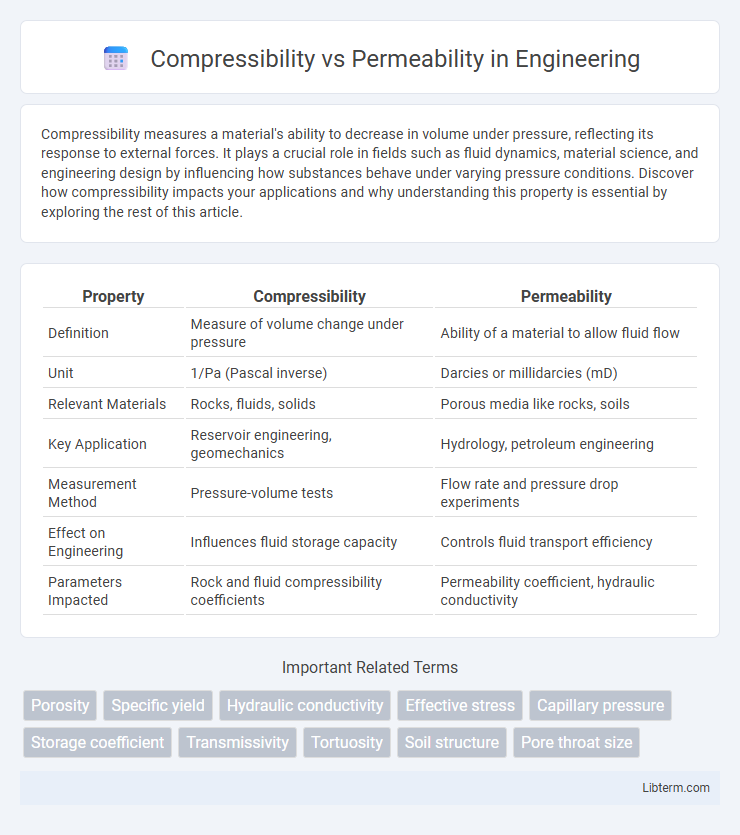Compressibility measures a material's ability to decrease in volume under pressure, reflecting its response to external forces. It plays a crucial role in fields such as fluid dynamics, material science, and engineering design by influencing how substances behave under varying pressure conditions. Discover how compressibility impacts your applications and why understanding this property is essential by exploring the rest of this article.
Table of Comparison
| Property | Compressibility | Permeability |
|---|---|---|
| Definition | Measure of volume change under pressure | Ability of a material to allow fluid flow |
| Unit | 1/Pa (Pascal inverse) | Darcies or millidarcies (mD) |
| Relevant Materials | Rocks, fluids, solids | Porous media like rocks, soils |
| Key Application | Reservoir engineering, geomechanics | Hydrology, petroleum engineering |
| Measurement Method | Pressure-volume tests | Flow rate and pressure drop experiments |
| Effect on Engineering | Influences fluid storage capacity | Controls fluid transport efficiency |
| Parameters Impacted | Rock and fluid compressibility coefficients | Permeability coefficient, hydraulic conductivity |
Introduction to Compressibility and Permeability
Compressibility measures a material's ability to decrease in volume under pressure, directly impacting reservoir behavior and fluid storage capacity. Permeability defines the ease with which fluids flow through porous media, controlling fluid movement within reservoirs and influencing production rates. Understanding both properties is critical for optimizing hydrocarbon recovery and designing effective reservoir management strategies.
Defining Compressibility: Key Concepts
Compressibility refers to the measure of a material's ability to decrease in volume under applied pressure, reflecting its elastic properties and fluid storage capacity. In reservoir engineering, compressibility quantifies how much the pore volume changes with pressure variation, influencing fluid flow and reservoir performance. Understanding compressibility is essential for accurate modeling of reservoir behavior and predicting production rates in comparison to permeability, which describes the ease of fluid flow through the porous medium.
Understanding Permeability in Materials
Permeability in materials refers to the ability of a substance to allow fluids or gases to pass through its pores, significantly impacting filtration and fluid transport processes. It is quantitatively measured by parameters such as Darcy's permeability coefficient, which depends on pore size, connectivity, and material structure. Unlike compressibility, which measures volume change under pressure, permeability directly influences applications in petroleum engineering, hydrogeology, and material science by controlling fluid flow efficiency.
Physical Factors Affecting Compressibility
Compressibility of a material is primarily influenced by factors such as porosity, grain structure, and fluid saturation, which govern how the volume changes under pressure. Higher porosity increases compressibility by allowing more space for deformation, while the mineralogical composition and cementation between grains impact the material's rigidity and volumetric response. Fluid compressibility and saturation level significantly affect the bulk compressibility, making these physical parameters critical in reservoir characterization and engineering calculations.
Main Influences on Permeability
Permeability is primarily influenced by pore throat size, connectivity, and the grain size distribution within the rock matrix, dictating fluid flow efficiency. Compressibility affects rock volume change under pressure but has a secondary impact on permeability by potentially altering pore space geometry. Understanding these factors is key for optimizing reservoir management and enhancing hydrocarbon recovery.
Differences Between Compressibility and Permeability
Compressibility measures a material's ability to decrease in volume under pressure, reflecting its volumetric elasticity, while permeability quantifies a material's capacity to transmit fluids through its pores. Compressibility is expressed in units like inverse pressure (Pa-1), indicating volume change per unit pressure, whereas permeability is measured in darcies or millidarcies, representing fluid flow rate per unit pressure gradient. Unlike compressibility, which relates to mechanical deformation, permeability directly concerns fluid flow characteristics in porous media.
Measurement Techniques for Compressibility
Measurement techniques for compressibility primarily include confined compression tests, which assess volume change under applied pressure in soil or rock samples. Laboratory methods such as oedometer tests quantify the soil's consolidation characteristics to determine compressibility parameters like the compression index and modulus of elasticity. Advanced techniques also involve isotropic compression tests using triaxial apparatus, enabling accurate evaluation of compressibility under controlled stress paths.
Methods to Assess Permeability
Permeability assessment methods include laboratory techniques like constant head and falling head permeability tests, which measure fluid flow through porous materials under controlled conditions. Field methods such as slug tests and pumping tests evaluate permeability by analyzing the response of aquifers to sudden changes in water levels, providing in-situ data. Advanced methods like computerized tomography (CT) scanning and nuclear magnetic resonance (NMR) imaging offer non-destructive visualization of pore structure, enhancing permeability characterization accuracy.
Real-World Applications: Compressibility vs Permeability
Compressibility and permeability are critical parameters in reservoir engineering affecting fluid flow and storage capacity in porous media. Compressibility influences how reservoir fluids and rock matrix volume change under pressure, essential for managing fluid extraction and reservoir compaction. Permeability determines the ease with which fluids can move through the reservoir rock, directly impacting production rates and recovery efficiency in hydrocarbon and groundwater extraction.
Conclusion: Importance in Engineering and Geoscience
Compressibility and permeability are critical parameters influencing fluid flow and mechanical behavior in porous materials, essential for reservoir engineering, hydrogeology, and soil mechanics. High compressibility affects volume changes under pressure, impacting storage capacity and deformation, while permeability controls fluid migration and extraction efficiency. Understanding their relationship enables optimized design and management of subsurface resources, ensuring stability and maximizing productivity in engineering and geoscience applications.
Compressibility Infographic

 libterm.com
libterm.com